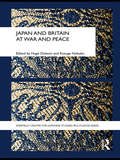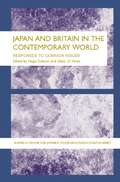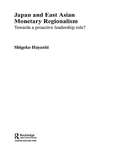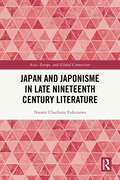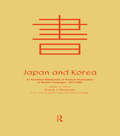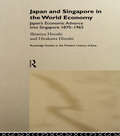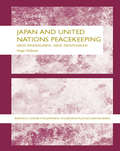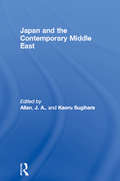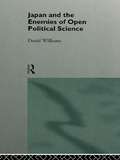- Table View
- List View
Japan and Britain after 1859: Creating Cultural Bridges
by Olive ChecklandIn the years following Japan's long period of self-imposed isolation from the world, Japan developed a new relationship with the West, and especially with Britain, where relations grew to be particularly close. The Japanese, embarrassed by their perceived comparative backwardness, looked to the West to learn modern industrial techniques, including the design and engineering skills which underpinned them. At the same time, taking great pride in their own culture, they exhibited and sold high quality products of traditional Japanese craftsmanship in the West, stimulating a thirst for, and appreciation of, Japanese arts and crafts. This book examines the two-way bridge-building cultural exchange which took place between Japan and Britain in the years after 1859 and into the early years of the twentieth century. Topics covered include architecture, industrial design, prints, painting and photographs, together with a consideration of Japanese government policy, the Japan-Britain Exhibition of 1910, and commercial spin-offs. In addition, there are case studies of key individuals who were particularly influential in fostering British-Japanese cultural bridges in this period.
Japan and Britain at War and Peace (The University of Sheffield/Routledge Japanese Studies Series)
by Hugo Dobson Kosuge NobukoSince the events of the Second World War the relationship between Japan and Britain has undergone an extraordinary transformation, from bitter conflict to peaceful alliance. Japan and Britain at War and Peace is a multilayered examination of this bilateral relationship with an emphasis on the issue of reconciliation. Reconciliation is explored in a broad sense and in a number of areas from economic cooperation and conflict, common concerns in the international system, public and media perceptions of each country, and the efforts of individuals, non-governmental organizations and governments to promote mutual understanding and find strategies to deal with dilemmas. With chapters from an international team of contributors from the UK, Japan, and Australia, this book will appeal to students and scholars of Japanese and British history and international politics.
Japan and Britain in the Contemporary World: Responses to Common Issues (The University of Sheffield/Routledge Japanese Studies Series)
by Glenn D. Hook Hugo DobsonBritian and Japan in the Contemporary World provides up-to-date analyses of these two countries in terms of economics, politics, security and identity on the global, regional, subnational and civic levels.The book moves beyond an analysis of state-to-state relations between Britain and Japan by examining the role of civil society in the relationship and analyzing the way the two countries deal with common issues, such as the 'special relationship' both maintain with the US; the relationship with the continents that both of these island nations border; the question of the degree of decentralization to allow within their contested borders. Both countries also face the pressures of globalization, as seen by the responses of the global cities of London and Tokyo.The editors have brought a selection of top scholars in a collection of chapters aimed at examining the similarities and differences in the way Britian and Japan respond to issues of common concern on these different levels.
Japan and China in the World Political Economy (Politics in Asia)
by Kellee S. Tsai Saadia M. PekkhanenTwo powers in East Asia today stand to define the region's economic and commercial future: Japan, which rose in a spectacular industrial burst to become at present the world's second largest economy; and China, which is rapidly advancing towards a market economy under the watchful eye of the world. While much has been made of Japan and China’s particular economic institutions and developmental paths, few works analyze them in a comparative framework. Including contributions from leading academics, the text focuses on the period from the 1980s to the onset of the 2000s, reviewing the experiences of Japan and China across the areas of development, trade, investment, finance and technology. Drawing on a combination of official documents, economic statistics, case studies and original fieldwork, this book will give political scientists, political economists, business concerns, and policy analysts a firmer grasp of the role Japan and China stand to play in the world political economy.
Japan and China: Mutual Representations in the Modern Era (The\writings Of Ser. #7)
by Matsuda WataruThis volume ties together the histories of Japan and China for the modern period prior to the 20th century. The chapters look at Chinese and Japanese works which were written in response to events in the other country. None of these works has received any sustained attention in the west. As a result we get a view of how Chinese and Japanese saw each other at a time when there were few personal contacts allowed. Many of these texts were built on fanciful embellishments of stories that migrated from one land to the other. But the unique qualities of the Sino-Japanese cultural bond seem to have conditioned the interaction so that these texts all reveal a fascinatingly well-defined area.
Japan and East Asian Monetary Regionalism: Towards a Proactive Leadership Role? (The University of Sheffield/Routledge Japanese Studies Series)
by Shigeko HayashiBased on original fieldwork including interviews held with Japanese officials, this text provides important new insight into Japan and East Asian relations, principally through the close examination of changes in Japan’s regional policy. Furthering discussions on Japan’s new regional activism, Hayashi explores how Japan and East Asian relations have developed, how Japan’s regional policy has changed, and why. In addition, the book challenges conventional views on Japanese foreign policy, arguing that it is not reactive but incrementally effective. The book incorporates three major case studies that provide detailed narratives and analysis of Japan and Washington’s diverging ideological approaches, Japan’s policies towards the East Asian financial crisis, and its policies towards East Asian regionalism.
Japan and East Asian Regionalism (Nissan Institute/Routledge Japanese Studies)
by S. Javed MaswoodThis book studies specific regional issues and problems, exploring recent related political developments in Japan, and how these might impact on future foreign policy priorities and objectives. The expert body of contributors consider issues such as: the nexus between domestic politics and foreign policy; environmental aid and management; human rights and democracy and conflict management.
Japan and Germany as Regional Actors: Evaluating Change and Continuity after the Cold War (Politics in Asia)
by Alexandra SakakiThe end of the Cold War and the bipolar era constituted a significant change in Germany's and Japan's foreign policy settings, granting both countries greater leeway to pursue policies divergent from Washington's strategy. This important book fills a gap in the existing literature by employing an explicitly comparative framework for analyzing and evaluating Germany's and Japan's post-Cold War regional foreign policy trajectories. Recent non-comparative studies diverge in their assessments of the extent to which the two countries' foreign policies are characterized by continuity or change, as while the majority of analyses on Germany find overall continuity in policies and guiding principles, prominent works on Japan see the country undergoing drastic change. Through a qualitative content analysis of key foreign policy speeches, this book traces and compares German and Japanese national role conceptions by identifying policymakers' perceived duties and responsibilities of their country in international politics. Further, through two case studies on missile defence policies and textbook disputes this study investigates actual foreign policy behaviour in order to question the assertion that post Cold War Germany and Japan are following very different paths. Providing a much needed new analysis of German and Japanese foreign policies, this book will be of great use to students and scholars interested in Japanese politics, German politics, comparative politics and international relations more generally.
Japan and Global Migration: Foreign Workers and the Advent of a Multicultural Society
by Mike Douglass Glenda RobertsJapan and Global Migration brings together current research on foreign workers and households from a variety of different perspectives. This influx has had a substantial impact on Japan's economic, social and political landscape. The book asks three major questions: whether the recent wave of migration constitutes a new multicultural age challenging Japan's identity as homogenous society; how foreign workers confront the many difficulties living in Japan; how Japanese society is both resisting and accommodating the growing presence of foreign workers in their communities.This book contains the most up to date, original data on Japanese migrant culture available. Its inescapable conclusion is that the multicultural age has finally come to Japan; the question is whether foreign workers will be legally and socially assimilated into the fabric of Japanese society or will continue to be treated as temporary entrants with limited civil rights. The book is written with postgraduate students in Asian studies, Japanese studies, political science, sociology, anthropology and migration studies, in mind.
Japan and Her People: Vol. I (Routledge Revivals)
by Anna C. HartshorneFirst published in 1902, this volume emerged contemporaneously with the Anglo-Japanese Treaty and explored the nation of Britain’s newest allies from an American perspective. Anna Hartshorne took her readers from experiencing Japan as unreal to utterly normal. She provided a thorough traveller’s guide including the voyage and first impressions, major locations and Japan’s peoples, culture and history. This is presented in two volumes along with 50 illustrations.
Japan and Her People: Vol. II (Routledge Revivals)
by Anna C. HartshorneThis book provides an overview of Japan in late 19th century and its history. It also provides an insight of Japanese society as it moved from the traditional Edo period lifestyle towards industrialization and explores Japan's lifestyles, customs, culture, and everyday behavior.
Japan and Japonisme in Late Nineteenth Century Literature (Asia, Europe, and Global Connections)
by Naomi Charlotte FukuzawaThis book examines the transnational phenomenon of Japonisme in the exoticist and “autoexoticist” literature of the late nineteenth century.Focusing on the way in which reciprocal processes of transcultural acquisition – by Japan and from Japan – were portrayed in the medium of literature, the book illustrates how literary Japonisme and the wider processes whereby Japan, with its alien exotic culture and unique refined aestheticism, was absorbing Western civilization in its own way in the late nineteenth century at the same time as the phenomenon of Japonisme was occurring in Western fine arts, which were inspired by traditional Japanese artistic practices. Specifically, the book focuses on the literary works of Lafcadio Hearn and Pierre Loti, who travelled from France and America, respectively, to Japan, and Mori Ōgai and Natsume Sōseki, who in turn went, respectively, to Germany and England from Japan.Exploring the eclectic hybridity of Japan’s modernization during the late nineteenth century, this book will appeal to students and scholars of Japanese Studies, Postcolonial Studies and Comparative Literature.
Japan and Japonisme: The Self and the Other in Representations of Japanese Culture
by Noriko MuraiJapan and Japonisme: The Self and the Other in Representations of Japanese Culture explores Japan’s engagement with and responses to Japonisme, and presents new perspectives on the history and enduring influence of Japonisme as a cultural discourse. The term "Japonisme" has come to encapsulate the West’s interests in Japanese arts and culture in the late nineteenth and early twentieth centuries. Japonisme contributed to Japan’s global reputation as an artistic nation, but it also produced persistent stereotypes about the Japanese, such as the image of "geisha."This pioneering anthology also demonstrates how Japan has espoused the modern Western fascination with its arts and culture to create and promote its national cultural identity. Japan and Japonisme introduces innovative studies on Japonisme by leading experts in the field, and covers the visual arts, art criticism and exhibitions, fashion, literature, horticulture, and popular culture in France, Italy, the United Kingdom, and the United States.
Japan and Korea: An Annotated Bibliography of Doctoral Dissertations in Western Languages 1877-1969
by Frank Joseph ShulmanFirst Published in 1971. This annotated bibliography of doctoral dissertations on Japan and Korea grew out of a decision to expand and bring up to date an earlier list entitled Unpublished Doctoral Dissertations Relating to Japan, Accepted in the Universities of Australia, Canada, Great Britain, and the United States, 1946-1963, compiled by Peter Cornwall and issued by the Center for Japanese Studies in 1965.
Japan and National Anthropology: A Critique (Routledge/Asian Studies Association of Australia (ASAA) East Asian Series #Vol. 6)
by Sonia RyangJapan and National Anthropology: A Critique is an empirically rich and theoretically sophisticated study which challenges the conventional view of Japanese studies in general and the Anglophone anthropological writings on Japan in particular. Sonia Ryang explores the process by which the postwar anthropology of Japan has come to be dominated by certain conceptual and methodological and exposes the extent to which this process has occluded our view of Japan.
Japan and Okinawa: Structure and Subjectivity (The University of Sheffield/Routledge Japanese Studies Series)
by Glenn D. Hook Richard SiddleJapan and Okinawa provides an up-to-date, coherent and theoretically informed examination of Okinawa from the perspective of political economy and society. It combines a focus on structure and subjectivity as a way to analyze Okinawa, Okinawans and their relationship with global, regional and national structures. The book draws on a range of disciplines to provide new insights into both the contemporary and historical place of Okinawa and the Okinawans.The first half of the book examines Okinawa as part of the global, regional and national structures which impose constraints as well as offer opportunities to Okinawa. Leading specialists examine in detail topics such as Okinawa as a frontier region, Okinawa's Free Trade Zones and response to globalization, and Okinawa as part of the Japanese 'construction state', being particularly concerned with how Okinawa can chart its own course. The second half focuses on questions of identity and subjectivity, examining the multitude of vibrant cultural practices that breathe life into the meaning of being Okinawan and inform their social and political responses to structural constraints.The originality of this book can be found in its elucidation of how the structural constraints of Okinawa's precarious position in the world, the region and as part of Japan impact on subjectivity. For many Okinawans, in the past as now, acceptance and rationalization of their dependency has made them collaborators in their own subordination. At the same time, however, they have demonstrated a capacity to give voice to a separate identity, inscribing cultural practices marking them as different from mainland Japanese.
Japan and Protection: The Growth of Protectionist Sentiment and the Japanese Response (Routledge Library Editions: Business and Economics in Asia #19)
by Syed Javed MaswoodIn the 1980s, the extent of Japanese export penetration into other Western economies, particularly the USA, became a matter of international concern. There were demands for Japan to reciprocate on imports, for the Japanese market to be 'opened up' and, by some people, for sanctions or a trade war if the Japanese did not respond. This book, first published in 1989, examines the growth of protectionist sentiment and the Japanese response to it. It examines in detail the debates within Japan and discusses the measures which the Japanese took, including the voluntary export restraint measure in the motor sector. It concludes that, broadly, the Japanese did indeed respond to world demands for their market to be opened up but that successful exporting to Japan depended equally on efforts by Western companies to service that market, which they were slow to do.
Japan and Singapore in the World Economy: Japan's Economic Advance into Singapore 1870-1965 (Routledge Studies In The Modern History Of Asia Ser.)
by Hiroshi Shimizu Hitoshi HirakawaThis pioneering work examines Japan's economic activities in Singapore from 1870 to 1965. Drawing upon a wide range of published and unpublished sources, the authors shed new light on issues such as:* prostitution* foreign trade by Kobe's overseas Chinese* fishermen in the inter-war period* Japanese economic activities during the Pacific War* Japan
Japan and UN Peacekeeping: New Pressures and New Responses
by Hugo DobsonJapan's postwar constitution in which the Japanese government famously renounced war forever has meant that the country has been reluctant, until recently, to commit its armed forces in the international arena. However, in the last decade or so, Japan has played a much more active role in peacekeeping and its troops have been deployed as part of UN
Japan and a New World Economic Order (Routledge Library Editions: Japan)
by Kyoshi KojimaPresident Nixon’s new economic policy of August 1971, aggravated by the oil problem since October 1973 caused chaos and uncertainty in the international trade and currency system. There were fears of another 1930s style depression. In addition, a world food shortage and strident claims by developing countries for perpetual sovereignty over resources added another set of difficulties. This volume, written from Japan’s standpoint, suggests a new direction for the world and regional economic order. The book tackles two major issues in international economics: Firstly, traditional international trade theory aims only at static maximization in the use of world human and material resources, but, the author stresses more attention should be paid to such dynamic or developmental elements as population growth, immigration, natural resource development, improvement in transfer of technology, economies of scale, direct foreign investment and economic integration in order to create development centres or sectors in the world economy. Secondly, the author discusses how to combine a global and regional approach to economic integration.
Japan and the Asian Pacific Region: Profile of Change (Routledge Library Editions: Japan's International Relations #1)
by Masahide ShibusawaThis book, first published in 1984, examines the spectacular economic growth of the Asia Pacific region in the 1970s and 1980s. How did a group of non-Western nations, in an area plagued by war, achieve such success, so quickly? Japan was the driving force in the region, and a dominant influence on the world economy, but had no clearly defined role in the politics of the region or the world. This book considers Japan’s position, the problems it faced and how it perceived and responded to events in the region. It provides clues to understanding the basic pattern of Japan’s relations, its evolving role in the region and the world, and how this role might develop in the future.
Japan and the Contemporary Middle East (SOAS/Routledge Studies on the Middle East)
by Kaoru Sugihara J. A. AllanJapan is an economic power of global significance; it is also the world's largest single national importer of oil. These two facts alone are sufficient to indicate the significance of Japan's relationship with the Middle East. But in fact, Japan's particularly strong interests in the Middle East extend well beyond oil, and include banking, investment, and an increasing concern with economic assistance.The studies in this book deal with the relevant period of the twentieth century and especially with the rapid transformation of Japan's relationship with the region since 1973. It provides access in English to the current economic and political analysis by Japanese specialists concerned with the Middle East, and it will assist anyone interested in Japan's relationship with the region. The dependence of Japan on Middle Eastern oil is examined together with the changing nature of Japan's energy consumption policies at home, and its involvement in joint ventures in the Middle East. Japan's role as a major provider of economic assistance is reviewed, and its future potential role in this area is emphasised.
Japan and the Dutch 1600-1853
by Grant K. GoodmanThis is the history of Dutch influence on Japan during the so-called 'closed centuries' between 1640 and 1853. Dutch maritime traders provided the only commercial link which Japan maintained with the west, and were thus the sole channel for western ideas and knowledge to reach neo-Confucian society. Professor Goodman explains the circumstances of the Dutch themselves in Japan during the seventeenth century, and the historical and intellectual milieu within which 'Dutch studies' were nurtured. He traces the initial interest of the Shogun government in European astronomy and medicine, and the gradual development of interest in wider spheres of western knowledge and culture.
Japan and the Enemies of Open Political Science (The\nissan Institute/routledge Japanese Studies)
by David WilliamsThe central argument of Japan and the Enemies of Open Political Science is that Eurocentric blindness is not a moral but a scientific failing. In this wide-ranging critique of Western social science, Anglo-American philosophy and French theory, Williams works on the premise that Japan is the most important political system of our time. He explains why social scientists have been so keen to ignore or denigrate Japan's achievements. If social science is to meet the needs of the `Pacific Century', it requires a sustained act of intellectual demolition and subsequent renewal.
Japan and the G7/8: 1975-2002 (The University of Sheffield/Routledge Japanese Studies Series)
by Hugo DobsonThis book analyses Japan's international relations and participation in the multilateral forum, the G8, since its creation in 1975. The author explores the motivation of the Japanese government and non-governmental actor's aims and objectives and examines how and to what extent they have been achieved. Presenting a wealth of new research this theoretically informed book will be of interest to those studying interntional relations and Japanese politics.

